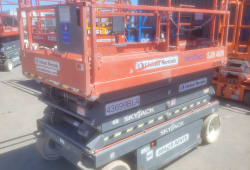Executing Predictive Maintenance for Heavy Equipment
14 Min read
)
August 12, 2023
In today's fast-paced industrial landscape, the efficient and uninterrupted operation of heavy equipment is paramount. Downtime can result in significant losses, impacting productivity, revenue, and customer satisfaction. That's where predictive maintenance comes into play - a proactive approach that leverages technology to prevent equipment failures and optimize maintenance schedules. In this article, we'll explore the concept of predictive maintenance and its importance in the heavy equipment industry. We'll also delve into the role of technology, the steps involved in implementation, the challenges encountered, and finally, examine some successful case studies and the future of predictive maintenance.
Understanding Predictive Maintenance
Predictive maintenance, also known as condition-based maintenance, is a strategy that aims to predict and prevent equipment failures by continuously monitoring machine health and performance. Unlike traditional reactive or preventive maintenance approaches, predictive maintenance takes advantage of real-time data and analytical tools to detect early signs of potential issues. By doing so, it enables maintenance teams to intervene and rectify problems before they escalate, minimizing downtime, and optimizing equipment lifespan and performance.
What is Predictive Maintenance?
Predictive maintenance involves the use of various sensors, data analytics, and diagnostic tools to gather and analyze real-time data on equipment health and performance. This data-driven approach helps maintenance teams identify patterns, trends, and anomalies that could indicate potential failures. By regularly monitoring critical parameters such as temperature, vibration, pressure, and fluid levels, companies can determine when maintenance is required and schedule it at the most opportune times, avoiding costly disruptions in operations.
Predictive maintenance goes beyond simply detecting issues; it also provides valuable insights into the root causes of equipment failures. By analyzing historical data and comparing it with real-time information, maintenance teams can identify recurring problems and implement targeted solutions. For example, if a particular machine consistently experiences overheating issues, the maintenance team can investigate the underlying causes, such as faulty cooling systems or inadequate ventilation, and take appropriate measures to address them.
The Importance of Predictive Maintenance in Heavy Equipment
In the heavy equipment industry, where machines operate under extreme conditions and in challenging environments, the impact of equipment failures can be significant. Unplanned downtime due to machine breakdowns not only causes delays in projects but also incurs costs associated with emergency repairs and the potential loss of clients. Predictive maintenance offers a proactive solution to these challenges, reducing downtime, improving safety, and enhancing overall operational efficiency.
Heavy equipment, such as construction machinery and mining equipment, is subjected to harsh operating conditions, including high temperatures, heavy loads, and constant vibrations. These factors can accelerate wear and tear, leading to premature equipment failures if not properly addressed. Predictive maintenance allows companies to monitor the performance of their heavy equipment in real time and detect any abnormalities that may indicate potential issues. By identifying these problems early on, maintenance teams can take preventive measures, such as lubrication, alignment adjustments, or component replacements, to avoid costly breakdowns and extend the lifespan of the equipment.
Furthermore, predictive maintenance in heavy equipment can also contribute to improving safety in the workplace. By continuously monitoring critical parameters, such as the structural integrity of equipment or the presence of hazardous substances, maintenance teams can ensure that the machines are operating within safe limits. This proactive approach helps prevent accidents and injuries, safeguarding the well-being of workers and minimizing the potential financial and reputational damages associated with workplace incidents.
The Role of Technology in Predictive Maintenance
Advancements in technology have revolutionized the world of predictive maintenance. Two key technologies that have greatly impacted the industry are the Internet of Things (IoT) and Artificial Intelligence (AI) powered by machine learning.
IoT and Predictive Maintenance
The IoT enables heavy equipment to be connected and communicate valuable operational data in real time. By embedding sensors and devices within the machinery, companies can monitor critical parameters remotely. This constant stream of data facilitates condition monitoring, allowing maintenance teams to identify deviations, predict failures, and schedule maintenance activities effectively. Ultimately, the IoT empowers organizations to move from reactive to proactive maintenance strategies, increasing reliability and reducing costs.
For example, consider a manufacturing plant that relies on a complex network of machines to produce goods. In the past, maintenance was often performed on a fixed schedule, resulting in unnecessary downtime and increased costs. However, with the integration of IoT devices, the plant can now monitor the performance of each machine in real time. If a machine starts to exhibit abnormal behavior, such as a sudden increase in temperature or a decrease in efficiency, an alert is sent to the maintenance team. This allows them to address the issue before it escalates into a major breakdown, minimizing downtime and maximizing productivity.
Furthermore, the IoT enables predictive maintenance based on actual usage and environmental conditions. By analyzing data from sensors embedded in the equipment, patterns ,and trends can be identified. For instance, if a machine tends to fail after a certain number of operating hours or when exposed to high humidity, the maintenance team can proactively schedule maintenance activities before a failure occurs. This approach not only reduces the risk of unexpected downtime but also extends the lifespan of the equipment, resulting in significant cost savings.
AI and Machine Learning in Predictive Maintenance
AI and machine learning algorithms analyze vast amounts of data collected by IoT devices to identify patterns, trends, and anomalies that humans might overlook. By training these algorithms with historical data, predictive models can be developed to forecast equipment failures with higher accuracy. As the models learn from real-time data, their predictive capabilities continually improve, enabling more precise condition-based interventions. AI-powered predictive maintenance not only reduces equipment downtime but also optimizes maintenance strategies, reducing costs and improving overall operational efficiency.
Consider a fleet of delivery trucks that are equipped with IoT sensors to monitor various parameters, such as engine performance, tire pressure, and fuel consumption. By feeding this data into an AI-powered predictive maintenance system, the fleet manager can anticipate potential issues before they occur. The system can detect patterns that indicate an impending breakdown, such as a gradual decrease in fuel efficiency or an increase in engine temperature. Based on these insights, the manager can schedule maintenance activities, such as replacing worn-out parts or conducting preventive repairs, ensuring that the trucks remain in optimal condition and minimizing the risk of unexpected breakdowns during deliveries.
Moreover, AI and machine learning algorithms can analyze historical maintenance data to identify the most effective maintenance strategies. By considering factors such as the age of the equipment, historical failure rates, and the cost of repairs, the algorithms can recommend the optimal maintenance approach for each piece of machinery. This allows organizations to allocate resources more efficiently, reducing unnecessary maintenance activities and associated costs. Additionally, by continuously learning from real-time data, the algorithms can adapt and refine their recommendations over time, ensuring that the maintenance strategy remains aligned with the evolving needs of the equipment.
In conclusion, the combination of IoT and AI-powered machine learning has transformed the field of predictive maintenance. These technologies enable organizations to monitor equipment in real-time, detect anomalies, and predict failures with higher accuracy. By adopting proactive maintenance strategies based on data-driven insights, companies can improve reliability, reduce costs, and optimize operational efficiency. As technology continues to advance, the role of technology in predictive maintenance will only become more crucial in ensuring the smooth operation of critical assets.
Steps to Implement Predictive Maintenance
Assessing the Current Maintenance Strategy
A suitable implementation of predictive maintenance starts with evaluating the existing maintenance strategy. Organizations need to assess their current practices, identify gaps, and understand areas for improvement. This evaluation helps in defining the goals and objectives of implementing predictive maintenance effectively.
During the assessment phase, it is important to gather data on the current maintenance practices. This can include information on the frequency of maintenance activities, the types of maintenance performed, and the costs associated with these activities. By analyzing this data, organizations can identify patterns and trends that can inform the development of a more effective predictive maintenance strategy.
Additionally, organizations should also consider conducting interviews or surveys with maintenance personnel to gain insights into their experiences and perspectives on the current maintenance strategy. This qualitative data can provide valuable information about any challenges or limitations of the existing approach.
Identifying Key Equipment for Predictive Maintenance
Not all equipment may require predictive maintenance. It is essential to identify and prioritize the critical machinery that can benefit from predictive maintenance strategies. By considering factors such as equipment criticality, historical failure rates, and maintenance costs, companies can focus their efforts on those machines that have the highest impact on their operations.
During the identification phase, organizations should conduct a thorough analysis of their equipment inventory. This can involve reviewing historical maintenance records, conducting equipment inspections, and consulting with subject matter experts. By gathering this information, organizations can determine which equipment is most susceptible to failure and would benefit the most from predictive maintenance.
It is important to note that the identification process should not solely rely on historical data. Organizations should also consider future operational requirements and changes in the business environment. By taking a proactive approach, organizations can ensure that their predictive maintenance strategy is adaptable and future-proof.
Implementing Predictive Maintenance Tools
To implement predictive maintenance effectively, organizations need to invest in suitable tools and technologies. This includes deploying sensors and IoT devices to monitor equipment health, implementing data analytics software for predictive modeling, and integrating these tools with existing maintenance management systems. Proper training and change management initiatives are crucial to ensure a smooth transition and successful implementation.
During the implementation phase, organizations should carefully evaluate different predictive maintenance tools and technologies available in the market. This can involve conducting pilot projects to test the feasibility and effectiveness of these tools in the specific operational context. By selecting the most appropriate tools, organizations can maximize the accuracy and reliability of their predictive maintenance program.
Furthermore, organizations should also consider the training and development needs of their maintenance personnel. This can involve providing specialized training on the new tools and technologies, as well as offering continuous learning opportunities to keep up with evolving industry practices. Change management initiatives, such as communication plans and stakeholder engagement strategies, should also be implemented to ensure a smooth transition and widespread acceptance of the predictive maintenance program.
By following these steps, organizations can successfully implement predictive maintenance and reap the benefits of improved equipment reliability, reduced maintenance costs, and increased operational efficiency.
Challenges in Implementing Predictive Maintenance
Predictive maintenance is a powerful approach that can revolutionize maintenance practices in organizations. However, its implementation comes with its fair share of challenges. Let's explore some of the key challenges that organizations may face when adopting predictive maintenance.
Technological Challenges
Implementing predictive maintenance requires organizations to embrace new technologies. This technological shift can pose several challenges:
1. Initial Setup Costs: Adopting predictive maintenance often involves investing in new hardware, software, and infrastructure. The initial setup costs can be significant, especially for organizations with limited budgets. However, it's important to note that the long-term benefits of predictive maintenance can outweigh the initial expenses.
2. Data Integration Complexities: Predictive maintenance relies on the collection and analysis of vast amounts of data from various sources. Integrating data from different systems and sources can be complex, especially if the organization's existing systems are not designed to work seamlessly together. Overcoming these integration challenges requires careful planning and collaboration between IT and maintenance teams.
3. Ensuring Interoperability: Organizations often have a mix of legacy and modern systems that need to work together for predictive maintenance to be successful. Ensuring interoperability between these systems can be a challenge, as different technologies may have different communication protocols and compatibility issues. Interoperability challenges can be addressed through the use of standardized protocols and careful system design.
4. Employee Training: To leverage predictive maintenance technologies effectively, employees need to be trained on how to operate and interpret the data generated by these systems. Training a workforce to embrace new technologies and analyze data can be a significant hurdle. However, investing in comprehensive training programs can empower employees and enable them to make informed decisions based on predictive maintenance insights.
Organizational Challenges
Implementing predictive maintenance goes beyond just adopting new technologies. It requires a shift in organizational mindset and culture. Let's explore some of the organizational challenges that organizations may encounter:
1. Shifting Mindset: Moving from reactive or preventive maintenance to a predictive maintenance approach requires a fundamental shift in how maintenance is perceived. All stakeholders, including management and maintenance teams, must understand the value proposition of predictive maintenance and actively support the new strategy. Overcoming resistance to change and fostering a culture of data-driven decision-making is crucial for successful implementation.
2. Reluctance to Rely on Data: Some organizations may be hesitant to rely on data-driven decisions, preferring to rely on experience or intuition. Convincing stakeholders to embrace predictive maintenance and trust the insights derived from data can be a challenge. Effective communication, highlighting success stories, and showcasing the tangible benefits of predictive maintenance can help overcome this reluctance.
3. Involvement of Key Personnel: To successfully implement predictive maintenance, it is essential to involve key personnel from various departments, including maintenance, operations, and IT. Their active involvement and collaboration are crucial for aligning goals, defining performance metrics, and ensuring the smooth adoption of predictive maintenance practices.
In conclusion, implementing predictive maintenance comes with a set of technological and organizational challenges. However, by addressing these challenges head-on and investing in the necessary resources, organizations can unlock the full potential of predictive maintenance, leading to improved decision-making, optimized maintenance practices, and ultimately, increased operational efficiency.
Case Studies of Successful Predictive Maintenance Implementation
Case Study 1
Company XYZ, a leading heavy equipment manufacturer, implemented a predictive maintenance program across its fleet of construction vehicles. By leveraging IoT-enabled sensors and AI-powered analytics, the company could proactively identify equipment anomalies and initiate maintenance actions before failures occurred. As a result, equipment downtime was reduced by 30%, leading to improved customer satisfaction and significant cost savings.
Case Study 2
In a mining operation, Company ABC implemented a predictive maintenance strategy for its fleet of mining trucks. By carefully selecting and implementing IoT sensors to monitor critical parameters such as engine performance, hydraulic pressures, and tire conditions, they were able to predict and prevent potential breakdowns. The result was a 25% reduction in maintenance costs and a 15% increase in equipment uptime, leading to improved operational efficiency and profitability.
The Future of Predictive Maintenance
Emerging Trends in Predictive Maintenance
As technology continues to advance, several emerging trends in predictive maintenance are expected to shape the future of the heavy equipment industry. These include the integration of augmented reality for remote troubleshooting, the use of drones for inspection and monitoring, and the development of predictive models based on real-time data from the cloud. These trends will further enhance the accuracy and effectiveness of predictive maintenance, driving improvements in equipment performance and reliability.
The Impact of Predictive Maintenance on the Heavy Equipment Industry
The adoption of predictive maintenance in the heavy equipment industry has the potential to revolutionize operations and significantly reduce costs. By minimizing equipment downtime, companies can ensure timely project completion, improve customer satisfaction, and optimize maintenance budgets. The ability to predict and prevent failures also enhances safety and reduces the environmental impact associated with emergency repairs and replacements. As predictive maintenance becomes more prevalent, heavy equipment manufacturers and operators will enjoy increased efficiency, reduced costs, and improved competitiveness.
In conclusion, implementing predictive maintenance in the heavy equipment industry is crucial for optimizing operational efficiency and minimizing downtime. With advancements in technology such as IoT and AI, organizations can proactively monitor their equipment's health, detect potential failures, and schedule maintenance more effectively. Although there are challenges in implementation, successful case studies showcase the potential benefits. The future of predictive maintenance promises even greater improvements in equipment reliability, efficiency, and cost-saving capabilities. As the heavy equipment industry continues to embrace predictive maintenance, businesses will stay one step ahead, ensuring smooth operations and staying competitive in this dynamic landscape.

Caleb Woods is an experienced content specialist and an editor at Boom & Bucket, blending his journalism background with expertise in the heavy equipment industry. He delivers engaging, informative content to help professionals stay informed and make smarter decisions in the machinery market.














